Affiliate Disclaimer
As an Amazon Associate I earn from qualifying purchases. It helps me keep the website going. Thank you for your support.
We all love the taste of a little treat; whether that be chocolate, candy, or a packet of chips. Horses are the same, and love eating treats too! But what things can you feed as treats for horses? And are treats just a tasty morsel, or can they be used in training or to help enhance health?
There is a wide variety of safe treats for horses: from fruits and vegetables to commercial treats and horse licks. However, there are also some things that must never be fed to horses, like dairy items or chocolate. The most important part is to feed treats responsibly, as too many treats can cause health and behavioral issues.
Treats can be more than just a way to show your horse you love them. They can be used as a training tool, and can even be used to improve your horse’s health. Read on to learn more about treats for horses and how to feed them correctly.
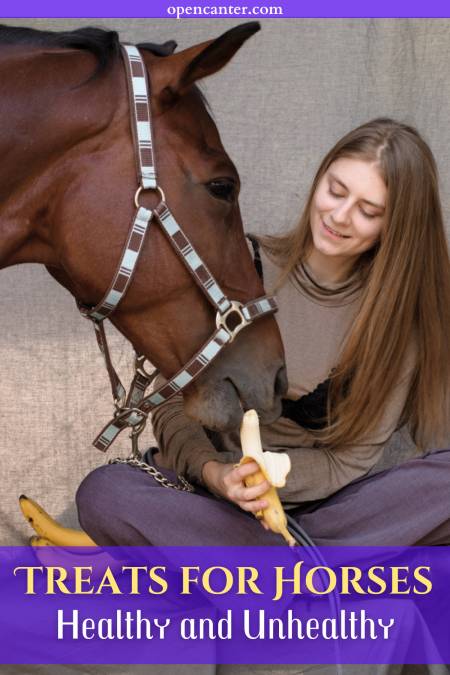
What Are the Benefits Of Treats For Horses?
Feeding treats to horses can have a number of benefits. The most obvious use for a treat is to reward good behavior. You can give your horse a treat to reward them for loading into a trailer or for standing calmly.
For Training
Treats are also a popular training tool for teaching horses new things. The treat is again used as a reward for the right behavior. This training technique is called positive reinforcement. Put simply, this means the trainer adds something the horse likes, to encourage the right behavior.
When you are teaching a horse something new, it is important to reward even the smallest try. Giving a treat as soon as the horse displays the required response makes them more likely to repeat it. Using treats during training may accelerate the rate at which the horse learns.
However, it is important not to over-treat your horse. Treats should only ever be fed in moderation. Horses that get too many treats can become demanding or nippy. They may also learn to expect a treat and misbehave when they do not receive one.
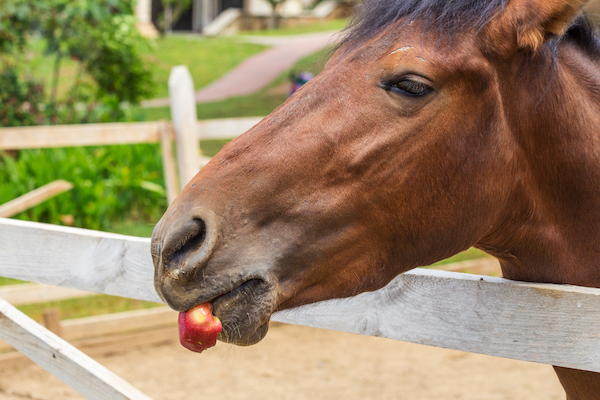
For Enrichment
Another use for treats is for enrichment. Horses who are kept in stalls or small paddocks need activities to help alleviate boredom. Putting treats into a puzzle feeder or hiding them in your horse’s hay can help keep them occupied.
Medication
Lastly, treats can be used to help give your horse medication. Often treats are quite strong in flavor and smell and can mask medications. Horses are very astute and will often notice as soon as you add something new into their feed.
Hiding the medication within a treat means your horse is more likely to consume the full dose. It also takes the stress out of administering medications to your horse. Always consult with your vet about any medications and the best way to administer them to your horse.
What Are Some Safe Treats for Horses?
There are many different types of safe treats for horses. However, each horse’s taste preferences may be slightly different. Some horses aren’t huge fans of apples but really love watermelon.
Here are the top ten most common horse treats:
1) Vegetables
The most common horse treat most people think of is carrots. However, other vegetables like pumpkin, celery, lettuce, and snow peas are also safe.
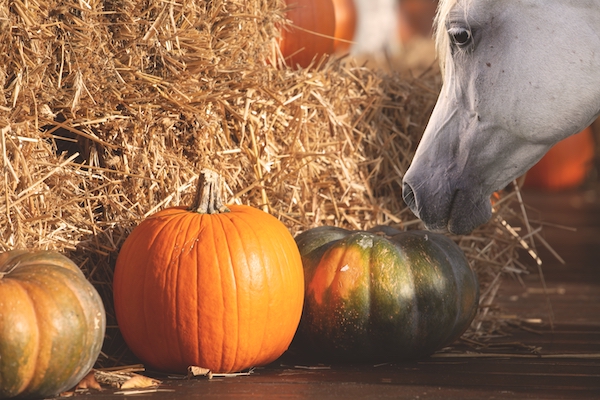
2) Fruits
Once again, the most common fruit people think of as a horse treat is an apple. However, horses also enjoy other fruits, like bananas, watermelon, strawberries, and grapes.
You can feed your horse fruits with pits but never feed these whole. The pit causes a choking hazard and must be removed before feeding to your horse. Examples of these fruits include apricots, peaches, and cherries.
3) Commercial Horse Treats
These are horse treats that are specially formulated for horses. They are readily available at tack shops, feed stores, and online.
There is a huge range of flavors, with popular options including apple, carrot, molasses, and peppermint. These are especially convenient as they tend to have a longer shelf life than other treats. Depending on the recipe, they may also be healthier for your horse.
4) Homemade Horse Treats
If you are good at baking, you can also make your own horse treats at home. There are a number of different recipes available with different ingredients.
You can tailor the recipe to suit your horse’s taste preferences. For example, for a recipe that uses molasses, you could substitute honey.
5) Grains And Pellets
These may already be included in your horse’s diet, as part of their normal daily feed. However, they can also double as a quick treat for your horse.
Depending on your horse’s workload, they may only receive a minimal amount of these feeds in their diet. However, as with any treat, you must only feed these in moderation. Excessive consumption, especially of grain, can cause stomach upsets.
6) Hay Cubes
Hay cubes can serve as a tasty treat, even if they are part of your horse’s normal diet. Hay cubes are compressed blocks of hay. Their small size makes them convenient to use as horse treats.
7) Sweet Candy Treats
Just like humans, some horses have a sweet tooth! Treats like licorice, sugar cubes, peppermints, or other lollies are popular with some horses.
8) Horse Lick Treats
These are treats that are designed for a horse to consume via licking. Often these licks include beneficial ingredients, like vitamins and minerals. However, they can still be used as a treat for your horse.
Licks often last a while and can be a good option for horses who get bored in stables or when tied up. Depending on the ingredients, they may contain less sugar than other treat alternatives.
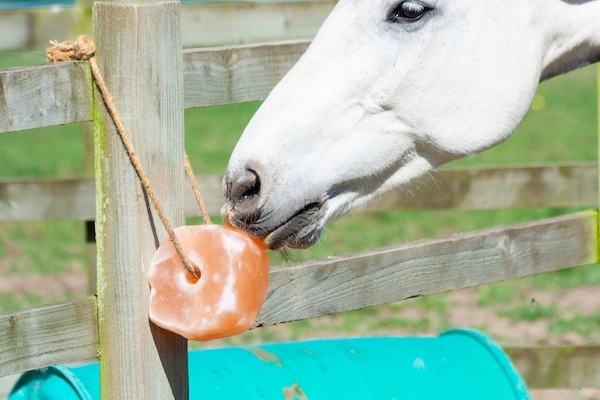
9) Specialized Treats
These are treats that are similar to commercial horse treats but have other benefits. For example, there might be glucosamine or biotin added for joint or hoof health.
These sorts of treats can be a tasty and efficient way to administer supplements or medication to your horse.
10) Bread
Lastly, another popular horse treat is bread. Some horse owners use bread as one of the main parts of their horse’s diet. However, this is not recommended. Bread has a high-calorie count and excessive phosphorus. (source)
However, as an occasional treat, some horses really love bread! Make sure that you only feed small handfuls at a time. This is to prevent the bread from ‘balling up’ and causing choke.
Are There Any Treats That I Should Not Give My Horse?
While there are plenty of safe treats for horses, there are also plenty of things you need to avoid. Here are some of the big no-nos when it comes to horse treats:
Meat
Horses are herbivores, meaning their stomach and liver are only designed to eat and process plants. While there is no evidence on what feeding meat does to horses, it is best to avoid it.
Chocolate
There are two reasons why you should avoid feeding chocolate to horses. Firstly, chocolate is known to have an ingredient called theobromine. This can cause seizures and internal bleeding in horses, and animals like cats and dogs.
Additionally, small amounts of chocolate have an effect similar to caffeine in horses. This can cause competition horses to fail drug tests.
Avocado
All parts of the avocado, including the leaves, stems, and bark of the tree, are toxic to horses. Avocados contain persin, which in severe cases can cause death.
Dairy Products
Once again, horses are not designed to consume milk or dairy products. They do not have the right enzymes in their stomach to be able to break down lactose.
Feeding anything with lactose in it as a treat can cause stomach upsets and diarrhea. Examples of foods containing lactose include milk, ice cream, and cheese. (source)
Certain Vegetables That Cause Excess Gas
Vegetables like broccoli, cauliflower, kale, and cabbage contain a specific type of sugar. When horses eat these vegetables, it can cause discomfort due to excess intestinal gas.
While this might seem funny – excess gas causes gas colic in horses. Colic can cause extreme pain and in severe cases can be fatal.
Vegetables That Are Part Of the Nightshade Family
These include potatoes, eggplants, bell peppers, and tomatoes. These vegetables contain atropine, which can cause damage to your horse’s nervous system.
Grains Or Pellets That Require Preparation
Some grains and pellets are unsuitable to feed unless they are prepared correctly. For example, feeding dry beet pulp flakes to your horse is never recommended.
This is because beet pulp flakes are required to be soaked before they can be safely fed to horses. Similar issues are seen with some grains that are required to be cooked or soaked before feeding.
Lawn Clippings
These might seem like the ultimate treat – but lawn clippings must never be fed to horses. They ferment in the stomach and cause colic, which is usually severe.
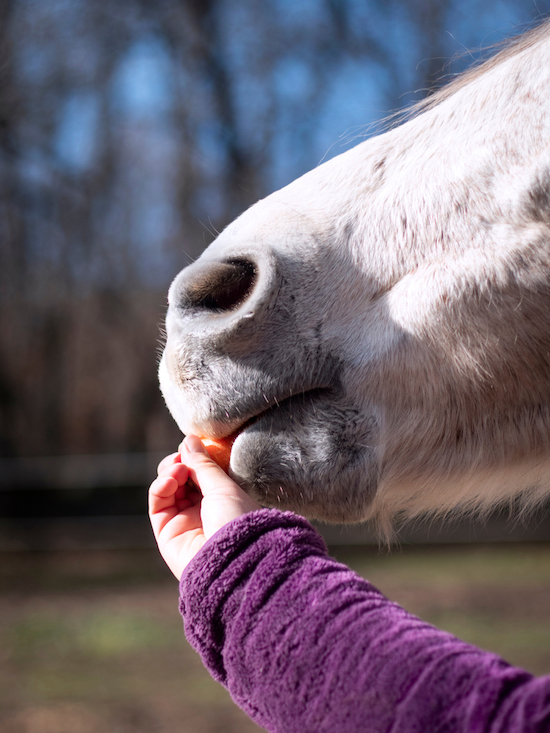
Can Too Many Treats Be Bad for Horses?
Most certainly! Treats should be reserved for special occasions or as rewards, and should always be fed in moderation. While there is no harm in giving your horse treats as part of your routine, they need to be carefully monitored.
For starters, giving your horse a treat every day at the same time can teach them to expect it. This can cause impatience, as well as tantrum-like behaviors should the treat not be offered. Horses can start to bite when expecting a treat and become dangerous to handle.
Additionally, feeding too many treats can cause health issues. Most treats are high in calories or sugar or may have an unusual balance of vitamins or minerals. While some commercial treats may have vitamins or minerals added, they may also have large amounts of sugar.
Feeding excessive sugar can lead to your horse becoming overweight. This can cause its own range of health issues, from insulin resistance to laminitis. Additionally, excessive treats can cause stomach upsets, especially if other parts of the horse’s diet are lacking.
Lastly, feeding treats too regularly means that they lose their ‘treat’ status. They are no longer a special reward, but part of the everyday routine.
Tips On Feeding Treats to Horses
There are a few special techniques that you should use to feed treats to your horse. These have been developed with your safety in mind. Horses are usually excited to receive treats, and you may be injured if you don’t feed them correctly.
You have a couple of different options when it comes to feeding treats. You can choose whether you want to feed by hand or offer treats in a bucket. The bucket option is generally much safer, especially if you have a rude or aggressive horse.
Feeding by hand requires a special technique. You must always offer the treat in the palm of a flat and outstretched hand. This helps to protect your fingers from being accidentally bitten. Feeding away from your body discourages your horse from nudging you or searching your pockets.
You can teach your horse to respond to a certain sound as a reward. This is the basis of clicker training. The horse learns that the noise of the clicker means they have done something correctly and can expect a reward. The result of this is that the horse only expects a treat after they hear the clicking noise. (source)
You also need to make sure that your treats are prepared correctly. It is recommended that fruits and vegetables be cut up into bite-sized pieces. This helps reduce the risk of choke.
It is also important that treats for horses are never cut into ‘discs’. Treats in this shape have the potential to become lodged and cause choke.
Final Thoughts
Horse treats are a great way to bond with your horse, reinforce positive behavior, and provide enrichment. However, you must feed treats responsibly to avoid adverse health effects and bad behavior. There are many different options when it comes to treats for horses, and each horse’s favorite treat can be different.



